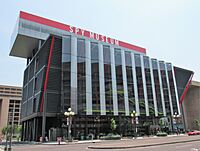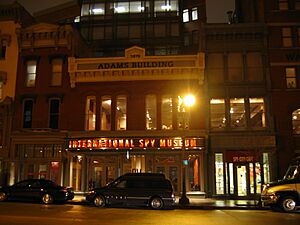International Spy Museum facts for kids
The International Spy Museum is a non-profit history museum all about the world of espionage and secret intelligence. It has the biggest collection of real spy gadgets from around the world that you can see anywhere.
The museum first opened in 2002 in Washington, D.C.. In 2019, it moved to a brand-new, bigger building at L'Enfant Plaza in the same city.
Contents
The Story of the Spy Museum
The idea for the museum came from Milton Maltz. During the Korean War, he worked as a code-breaker, so he knew a lot about the secret world of spying. In 1996, he decided to create a museum to share this hidden history with the public.
The first museum opened in 2002 and cost about $40 million to build. It was a big success and helped make its neighborhood, called the Penn Quarter, a more exciting place to visit.
By 2015, the museum needed more space. A new, modern building was designed, and the museum moved there in 2019. The new building cost $162 million and has cool features like a movie theater and a rooftop terrace. The museum also offers fun and educational programs for students and families.
What Can You See at the Museum?
The museum has over 7,000 spy artifacts, and about 1,000 of them are on display for visitors. You can see how spying has changed over time, from ancient history to today. The collection includes items from the American Revolutionary War, the Cold War, and even modern cyber-spying.
Amazing Spy Gadgets
Here are some of the incredible items you can see:
- Japanese Enigma Machine: A rare code machine Germany built for its ally, Japan, during World War II. It was used to send secret messages.
- U-2 Spy Plane Wreckage: Pieces of the actual U-2 spy plane flown by pilot Francis Gary Powers that was shot down.
- ... Pin Silver Dollar: A coin made by the CIA for U-2 pilots. It had a hidden pin for emergencies.
- Bay of Pigs Flag: This flag was supposed to be flown by a group of fighters to signal a victory in Cuba in 1961, but the mission failed.
- KGB Buttonhole Camera: A tiny camera hidden in a coat button, used by spies from the Soviet Union's KGB.
- Lipstick Pistol: A single-shot pistol disguised as a tube of lipstick, also used by the KGB during the Cold War. It was nicknamed the "Kiss of Death."
- Pigeon Camera: A copy of a camera from World War I that was attached to pigeons to take secret photos from the air.
- Aston Martin DB5: The famous gadget-filled car from the James Bond movie Goldfinger.
Your Undercover Mission
When you visit the museum, you don't just look at things—you become a spy! The exhibits take you on a journey through the world of espionage.
Briefing Center
Your visit starts in the Briefing Center. Here, you get a secret identity and an "Undercover Mission" badge. A short film introduces you to the shadowy world of spying and prepares you for your mission.
Stealing Secrets
In this gallery, you'll learn about the people behind the spying: the agents, their bosses, and the clever engineers who invented the gadgets. You can see hundreds of amazing tools used to steal secret information.
Making Sense of Secrets
How do spies understand the information they collect? This gallery shows you how secret messages are turned into useful intelligence. Interactive displays let you try your hand at making and breaking codes.
Covert Action
This gallery explores how spies secretly influence events in other countries. You'll learn about famous covert missions, including both amazing successes and major failures.
Spying That Shaped History
Discover how spying has changed the course of history. This gallery features stories from the American Revolution all the way to modern cyberwarfare. You can also hear what real intelligence officers think about spies in movies.
An Uncertain World
Learn how spy agencies work to protect their countries from threats. This gallery looks at spy stories from long ago in Venice to the tense times of the Cold War in Berlin.
Debriefing Center
At the end of your visit, you'll go to the Debriefing Center. Here, your Undercover Mission comes to an end. You'll get a report on how well you did and find out what your top spy skills are.
See also
 In Spanish: Museo Internacional del Espionaje para niños
In Spanish: Museo Internacional del Espionaje para niños




